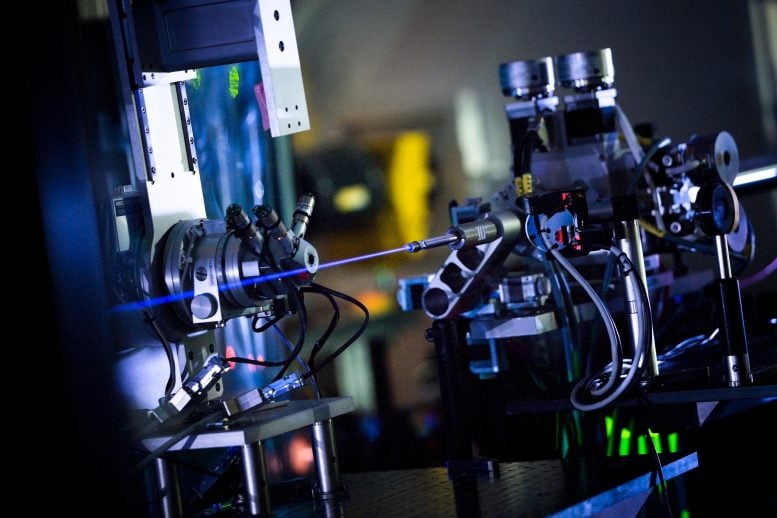
The X-ray beam from the world’s largest X-ray laser, the European XFEL, only becomes as clearly visible as in the photo in complete darkness and with an exposure time of 90 seconds. In 2024, the first experiments to detect quantum fluctuations in vacuum will take place here. Credit: European XFEL / Jan Hosan
The team at HZDR suggests improvements for an experiment aimed at investigating the boundaries of physics.
Absolutely empty – that is how most of us envision the vacuum. Yet, in reality, it is filled with an energetic flickering: the quantum fluctuations. Scientists are currently scientists are gearing up for a laser experiment intended to verify these vacuum fluctuations in a novel way, which could potentially provide clues to new laws in physics.
A research team from the Helmholtz-Zentrum Dresden-Rossendorf (HZDR) has developed a series of proposals designed to help conduct the experiment more effectively – thus increasing the chances of success. The team presents its findings in the scientific journal Physical Review D.
The physics world has long been aware that the vacuum is not entirely void but is filled with vacuum fluctuations – an ominous quantum flickering in time and space. Although it cannot be captured directly, its influence can be indirectly observed, for example, through changes in the electromagnetic fields of tiny particles.
However, it has not yet been possible to verify vacuum fluctuations without the presence of any particles. If this could be accomplished, one of the fundamental theories of physics, namely quantum electrodynamics (QED), would be proven in a hitherto untested area. Should such an experiment reveal deviations from the theory, however, it would suggest the existence of new, previously undiscovered particles.
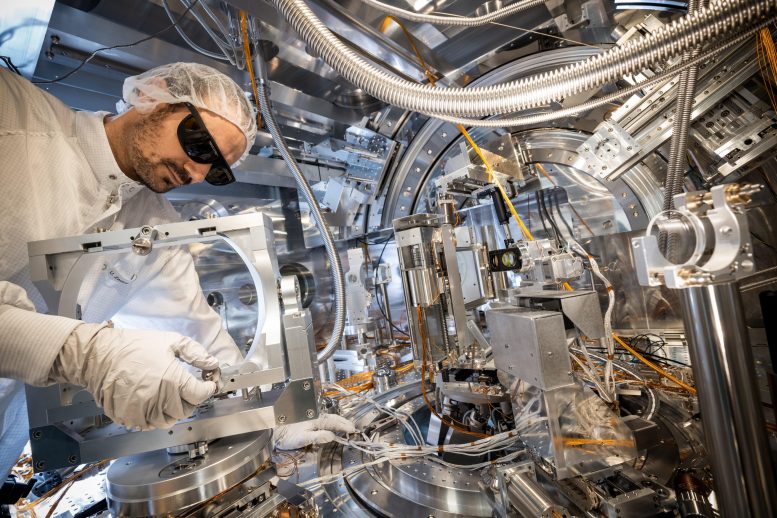
Dr. Ulf Zastrau heads the HED (High Energy Density Science) experimental station at the European XFEL. In the HED beam chamber the flashes from the world’s largest X-ray laser must meet the light pulses from the ReLaX high-power laser operated by the HZDR in order to detect vacuum fluctuations. Credit: European XFEL / Jan Hosan
The experiment intended to accomplish this is planned as part of the Helmholtz International Beamline for Extreme Fields (HIBEF), a research consortium led by the HZDR at the HED experimental station of the European XFEL in Hamburg, the largest X-ray laser in the world. The underlying principle is that an ultra-powerful laser fires short, intense flashes of light into an evacuated stainless steel chamber. The aim is to manipulate the vacuum fluctuations so that they, seemingly magically, change the polarization of an X-ray flash from the European XFEL, i.e., rotate its direction of oscillation.
“It would be like sliding a transparent plastic ruler between two polarizing filters and bending it back and forth,” explains HZDR theorist Prof. Ralf Schützhold. “The filters are originally set up so that no light passes through them. Bending the ruler would now change the direction of the light’s oscillation in such a way that something could be seen as a result.” In this analogy, the ruler corresponds to the vacuum fluctuations while the ultra-powerful laser flash bends them.
Two flashes instead of just one
The original concept involved shooting just one optical laser flash into the chamber and using specialized measurement techniques to register whether it changes the X-ray flash’s polarization. But there is a problem: “The signal is likely to be extremely weak,” explains Schützhold. “It is possible that only one in a trillion X-ray photons will change its polarization.”
But this might be below the current measurement limit – the event could simply fall through the cracks undetected. Therefore, Schützhold and his team are relying on a variant: instead of just one, they intend to shoot two optical laser pulses simultaneously into the evacuated chamber.
Both flashes will strike there and literally collide. The X-ray pulse of the European XFEL is set to fire precisely into their collision point. The decisive factor: The colliding laser flashes affect the X-ray pulse like a type of crystal. Just as X-rays are diffracted, i.e., deflected, when passing through a natural crystal, the XFEL X-ray pulse should also be deflected by the briefly existing “light crystal” of the two colliding laser flashes.
“That would not only change the polarization of the X-ray pulse but also slightly deflect it at the same time,” explains Ralf Schützhold. This combination could increase the chances of actually being able to measure the effect – so the researchers hope. The team has calculated various options for the striking angle of the two laser flashes colliding in the chamber. Experiments will show which variant proves to be most suitable.
Targeting ultra-light ghost particles?
The prospects could even be improved further if the two laser flashes shot into the chamber were not of the same color but of two different wavelengths. This would also allow the energy of the X-ray flash to change slightly, which would, likewise, help to measure the effect. “But this is technically quite challenging and may only be implemented at a later date,” says Schützhold.
The project is currently in the planning stages in Hamburg together with the European XFEL team at the HED experimental station, and the first trials are scheduled to launch in 2024. If successful, they could confirm QED once more.
But perhaps the experiments will reveal deviations from the established theory. This could be due to previously undiscovered particles – for example, ultra-light ghost particles known as axions. “And that,” says Schützhold, “would be a clear indication of additional, previously unknown laws of nature.”
Reference: “Detection schemes for quantum vacuum diffraction and birefringence” by N. Ahmadiniaz, T. E. Cowan, J. Grenzer, S. Franchino-Viñas, A. Laso Garcia, M. Šmíd, T. Toncian, M. A. Trejo and R. Schützhold, 10 October 2023, Physical Review D.
DOI: 10.1103/PhysRevD.108.076005

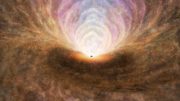
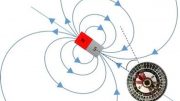
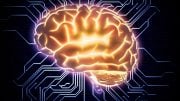
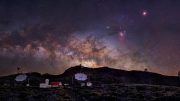




Scientific experiments are omnipotent, which is a typical pseudo scientific idea. Scientific research guided by correct theories can enable humanity to stand higher and see further. Every science enthusiast hopes that true science is not fooled by so-called academic journals (such as Physics Review Letters, Science, Nature, etc).
Wishing you all success.
Physics Review Letters (PRL) hardly know what shame is. The two-dimensional images in mathematics are meaningless for them. They would rather believe in baseless imagination than believe in mathematics. They firmly believe that two objects (such as two sets of cobalt 60) rotating in opposite directions can form a mirror image of each other. They are unwilling to believe that scientific experiments are limited by nature, so they go further and further on the path of pseudoscience, even lazy to turn back.
The spirit of science has long been lost to them. The collective silence in today’s academic community is a true reflection of the prevalence of these pseudo academic journals. This is precisely the greatest tragedy of the academic community in the 21st century. Your article has been published in such a journal. Is it worth showing off?
If anyone is really interested in science, you can browse https://www.zhihu.com/column/c_1278787135349633024.